
|
The Drake Equation, Fermi Paradox, and SETI |

|
The Drake Equation, Fermi Paradox, and SETI |
|
People have long wondered whether we are unique or not. Frank Drake of Cornell University formulated what is now known as the Drake Equation in 1960 as a way to open the discussion on the possibility of intelligent life in the galaxy. At left is the Drake Equation and the meaning of the terms in the Drake Equation. We consider each term in the Drake Equation and come up with an answer as to the number of intelligent civilizations likely to exist in the Milky Way galaxy. The terms in blue are probabilites and facts which can be deduced from astrophysics. These terms can, in principle, be determined quantitatively. The sections in green are probabilities and numbers which come from biology, psychology, and sociology. These are much more difficult to estimate. |
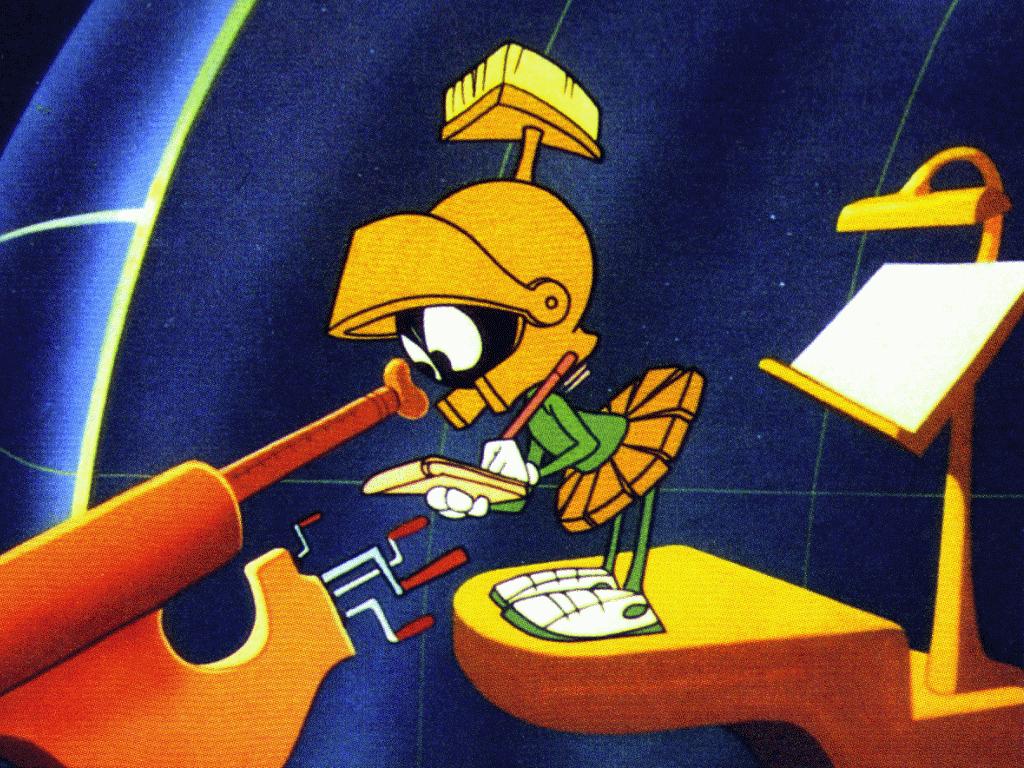
|
|
The Fermi Paradox takes the tact that we wish to argue by contradiction. It is first argued that, although interstellar travel is slow, it is still possible to explore the Milky Way galaxy in several hundred million years, even given our technological level (or nearly our technological level). Conequently, because the Milky Way is at least 10 billion years old, there has been plenty of time for civilizations to explore the Milky Way galaxy. The Fermi Paradox then posits that if this is indeed true, then why have we not found evidence of extra-terrestrial civilizations?
In the next few sections, we go through the possibilities (and strategies) for interstellar travel and exploration.
 |
The Earth has been broadcasting to space with powers up to 500 kWatts, nearly the power of the Arecibo M13 message, for the last 50 or so years (radio and television) and so we have been announcing ourselves to the Galaxy (inadvertently announcing ourselves) for a while. However, with the advent of digital signals, the power leaked to space has gone way done and so this inadvertent CETI has essentially stopped. |
The Milky Way galaxy is large, the visible disk of stars is around 100,000 light years across (around 6x1017 miles). The nearest star to the Earth, excluding the Sun, is Proxima Centauri which is around 4.3 light years from the Earth. So, if a spacecraft could travel at the spped of light, c, it would take 4.3 light years for the ship to travel from Proxima Centauri to the Earth and it would take ~100,000 years for it to travel across the Galaxy. This simple argument would suggest that perhaps a very technically advanced civilization could easily explore the Galaxy over the lifetime of the Galaxy, > 10 billion years.
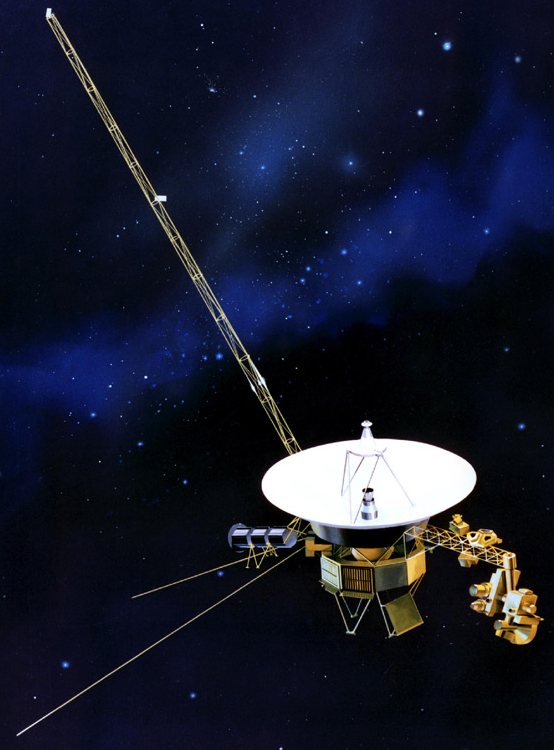 |
|
 |
If the civilization is roughly like ours and uses space probes similar to ours the argument is changed. (In the left panel we show an artist's rendition of Voyager. In the right panel we show the disk carried by Voyagers 1 and 2. The Pioneer probe also carried plaque as it explored the Solar System and beyond.) For example, we live in a planetary system dominated by the Sun, our star. When we send probes into space such as the Voyagers, we try to do it in an economical way; we launch the probes just fast enough to escape the Earth and to reach their desired destinations. If we want a probe to escape the Solar System, we would give it the escape velocity from the Solar System. From the orbit of the Earth, this corresponds to a speed of ~150,000 kilometers per hour.
The Pioneer 10 and 11 probes were launched in 1972 and 1973 and have left the Solar System. We received the last signal from them on January 23, 2003. Pioneer 11 is headed in the direciton of the constellation Aquila and will pass near one of its stars in 4 million years.
In the 1970s NASA launched Voyagers 1 and 2 to tour the outer Solar System and beyond. Currently, Voyagers 1 and 2 are leaving the Solar System traveling at speeds of 3.6 Astronomical Units per year (roughly 63,000 kilometers per hour) and 3.3 Astronomical Units per year (roughly 57,000 kilometers per hour), respectively. In 40,000 years, Voyager 1 will pass within 1.6 light years of AC+79 3888 in the constellation Camelopardalis. In 296,000 years, Voyager 2 will pass witin 4.3 light years of Sirius, the brightest star in the sky.
It is not clear, however, how far the Pioneers and Voyagers can wander through the Galaxy before they meet their ends.
If the extraterrestrial civilization lives in a planetary system to ours and is also interested in economy, then we would expect that it would also send out probes with speeds like those of Voyagers 1 and 2, speeds on the order of 60,000 kilometers per hour or so. In this case, the trip from Proxima Centauri would take
and a trip across the Galaxy would require 190 million years. Such times are both shorter than the age of the Galaxy and thus still plausible that extraterrestrials could explore the Galaxy over the lifetime of the Galaxy. From a practical standpoint, the exploration of the Galaxy is likely a multi-generational exercise. Motivation and drive will then play large roles in whether any civilization is willing to undertake such an adventure. The exploration of the Galaxy is then a psychological and sociological question as well as a simple scientific question.
Von Neumann Machines:
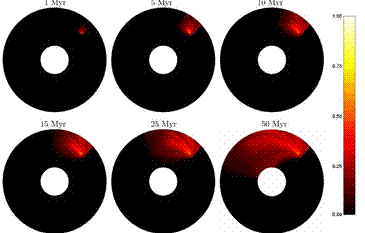 The above series shows the rate at which interstellar civlization spreads. After only 50 million years it has spread over a large chunk of the Galaxy. | Cotta and Morales (2009) performed a simple exercise. They start with a technological civilization which sends out eight probes each traveling at 10 % the speed of light. These probes carry subprobes for use to explore further. Each set of subprobes carry subprobes, and so on. That is, the probes act as von Neumann machines , machines capable of replicating themselves. The game is then, the eight probes will reach their destinations after a certain amount of time elapses. When they reach their destinations, they set up civilizations (bases) which last for N years, and then send out eight more probes. So, we see that there are now 64 probes moving outward. These sixty-four probes reach their destinations, set up bases, and each sends out eight more probes. After this stage, there are now 512 probes. This process continues until the probes die. |
If the bases last 1 million years, there can be no more than 1,000 civilizations for probes which last 50 million years or we would have found evidence of extraterrestrial civilizations. If the bases last 100 million years, then there are not likely to be more than 10 extraterrestrial civilizations. Again, like the inferences drawn from the Drake Equation, conclusions based on the Fermi Paradox also depend on the assumption of key numbers and questions (implicit questions) on the motivation of technologically advanced civilizations.
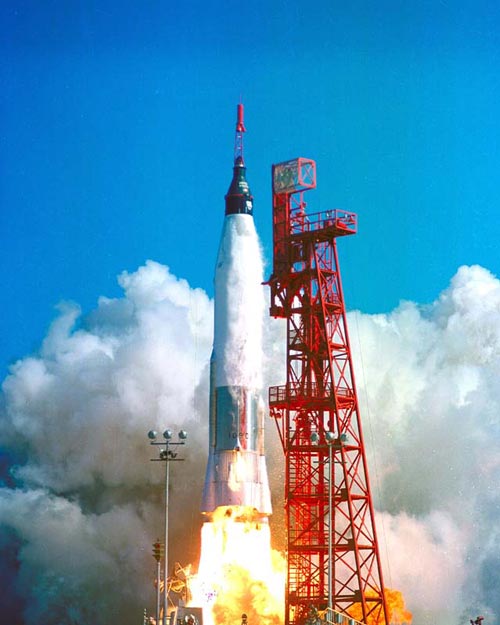 |
|
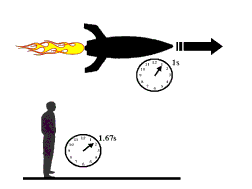 |
There is an interesting feature of Einstein's Special Theory of Relativity which affects this issue. For a brief discussion of Special Relativity go to this link. Because of the property of spacetime that it is malleable, not rigid (which also includes the time part) time does not have to flow at the same rate for all observers. In fact, it has been amply demonstrated by experiment that moving clocks run more slowly than stationary clocks! The rate at which a moving clock runs is given by the formula to the right. For the rider on the rocket (see left panel), let's say his watch reads that t = 10 hours have elapsed. If the rocket is traveling at speed v = 0.9 c, then, amazingly, it turns out that the watcher (on the ground) would find that his clock would read that roughly t' = 23 hours elapsed over the same time interval. |
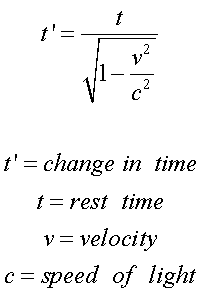 |
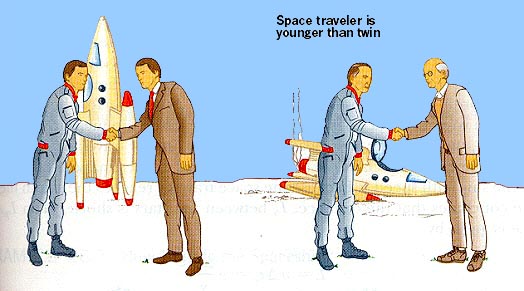
|
|
But wait, according to Einstein, time dilation says that, according to a stationary observer, a moving clock runs more slowly than the stationary clock. This fits nicely so far as it suggests that the traveling twin's clock does indeed tick more slowly than the stay-at-home twin. The paradox arises because all that is really needed is that two observers are in relative motion for time dilation to occur. So, if we were to consider the situation from the point of view of the traveling twin, we would come to a different conclusion. The traveling twin sees the stay-at-home twin running away from him as he speeds toward Proxima Centauri, that is, he believes that the stay-at-home twin is the one who was in motion. Consequently, he believes that the stay-at-home twin's clock is the one that ran more slowly and he is surprised when they re-unite and the stay-at-home twin has actually aged more. This is the Twin Paradox. For an explanation of the paradox see here.
|
Let us set the stage for a moment. How do we describe the location of events which occur in the Universe? Is it sufficient to give simply the where of the event? No, in order to define uniquely the event, we must also say when the event takes place. That is, if we want to define events in our Universe we must give the location and time of the event. In this sense, time acts as just another coordinate in the Universe much as we define the x,y,z positions for objects in space. This, however, immediately points out that time, although apparently just another coordinate for Universal events, seems to have special properties--we return to the specialness of time later. Space and time form a structure, spacetime, on which (in which) events in the Universe take place. But his also begs the question of whether space and time are things or mathematical constructs. |
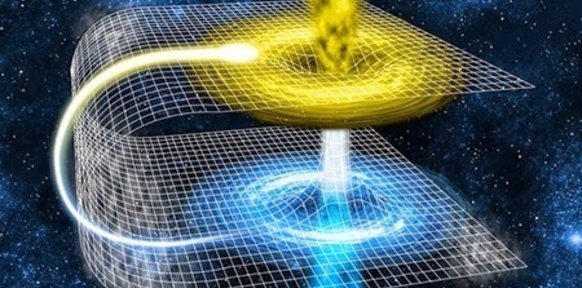
|
 |
|
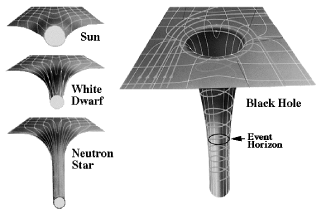 |
Albert Einstein and Spacetime Einstein relaxed the conditions of fixed space and time; he considered non-rigid space and stretchy-squishy time in his famous theories of relativity (the theories of Special Relativity and General Relativity). A notion contained in his General Theory was that of the nature of gravity. Newton postulated a Universal Law of Gravitation, but did not understand how gravity worked. Einstein postulated that effects of gravity arose because of the non-rigid nature of space. Mass distorts the structure of space. In a two-dimensional space, situations such as shown to the left may arise. The black hole actually pinches down to a point (the singularity) surrounded by something called the event horizon. Once the event horizon is crossed you can no longer communicate with the rest of the universe. | 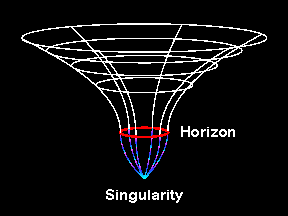 |
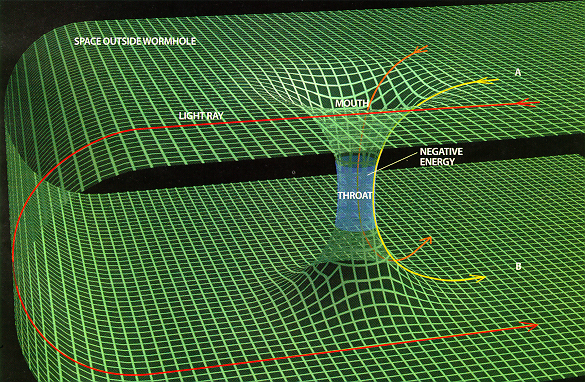 |
A black hole is surrounded by an event horizon which is a one-way gate into its insides. Interestingly, can also envision a solution where time is reversed so that one can make a white hole surrounded by a horizon, also a one-way gate, but everything flows outward. Hooking up two such beasts forms what is known as an Einstein-Rosen bridge, an example of a wormhole. Such objects are unstable in the presence of ordinary matter. As one tries to traverse the wormhole, the pinching in of the throat compresses the material increasing its gravitational pull of the walls of the wormhole further compressing it. This can be overcome if an AAC was around. Material which acted as if it had negative mass could be manufactured which would serve as a repulsive force to keep the throat of the wormhole open as the material passed through! Conceivable but whether it is likely or not is questionable. |
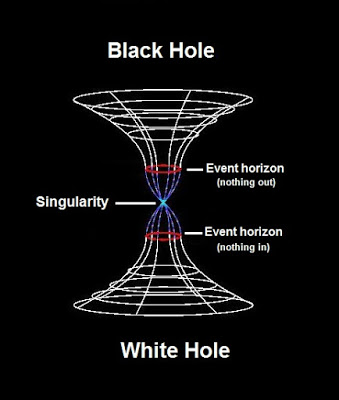
|